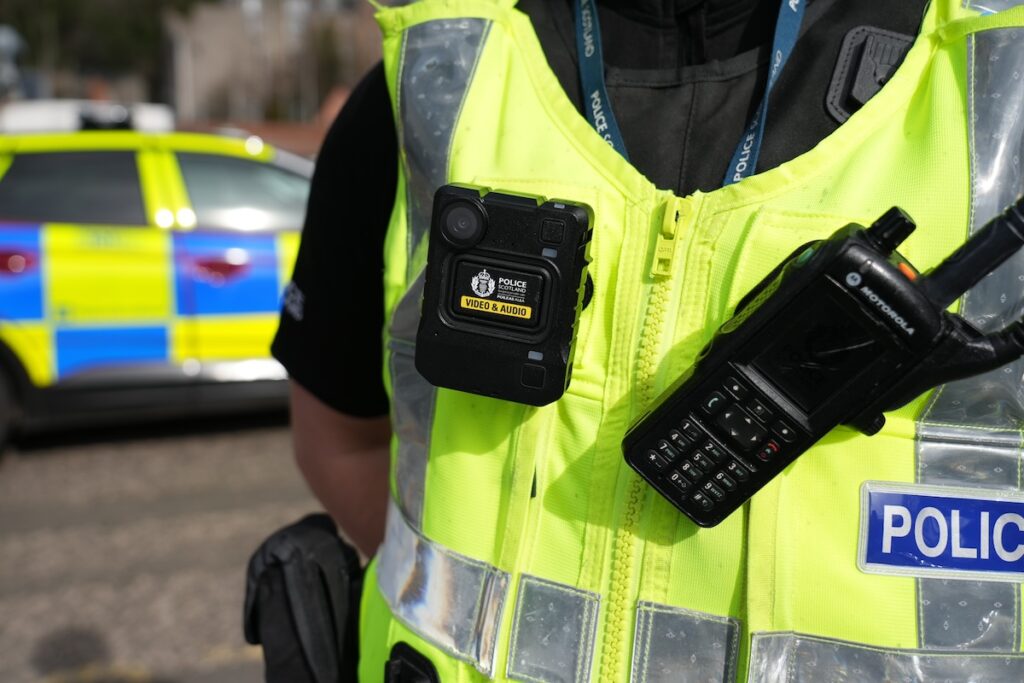Police officers in Tayside became the first to be equipped with new body-worn video (BWV) cameras as a national rollout of the technology began today.
Around 750 officers in the region, including road policing officers and dog handlers, will be equipped with the new devices over the coming weeks as part of a force plan to improve the quality of evidence and speed up justice.
More than 10,500 Home Office approved Motorola Solutions VB400 cameras are set to be issued to frontline officers from constable to inspector ranks, and to police custody staff, across the country, as part of the modernisation programme.
Chief Constable Jo Farrell has prioritised the introduction of body worn video since taking on the role as head of Police Scotland in 2023.
However, it was not an easy process. Despite numerous hearings at the Scottish Parliament, the force had struggled to make the case to politicians, leaving it to fall behind other constabularies across the country.
After a near five-year delay, which was branded ‘shamefully slow’ last year, the technology is finally being deployed. In a statement released this afternoon, the force said the tech will ‘help to de-escalate incidents, improve public trust in policing and reduce complaints, support officer and staff safety, and bring wider benefits to the criminal justice system’.
Chief Constable Farrell said: “The national roll out of body worn video has commenced with the first police officers out on patrol in Tayside today. All frontline officers and custody staff in Tayside Division will be equipped over the coming weeks.
“During the next 18 months, you will see a gradual increase in officers with body worn video cameras across Scotland. In cities and rural communities, in our communities on the roads, hospitals and schools and anywhere else they are required to carry out their duties.”
She added: “Body worn video can significantly enhance public confidence and support officer and public safety by providing effective and transparent evidence of police and public interactions.
“The technology will also improve the quality of evidence presented in court to deliver faster justice for victims by increasing early guilty pleas and reducing time spent at court for victims, witnesses and police officers.
“There is strong public and partner support for body worn video in Scotland and we will continue to explain our use of this important technology including assurance around data privacy and human rights considerations.”
The national roll out was a key recommendation of Lady Elish Angiolini’s independent review of police complaints, published in November 2020. She had highlighted evidence from the Mayor’s Office for Policing and Crime in London that the use of body‑worn video cameras in the Metropolitan Police Service area had seen a one‑third reduction in complaints.
Police Scotland’s own national public consultation on body worn video received more than 9,000 responses and showed overwhelming support for its introduction, with 81 per cent agreeing that it would increase public confidence in policing.
Angela Constance, Cabinet Secretary for Justice and Home Affairs, said: “I am very pleased that the Scottish Government’s record investment in Police Scotland is continuing to support the national roll-out of body worn video for officers and staff.
“Body worn video can increase public confidence in policing and improve safety for police officers and staff. It can also benefit victims and witnesses of crime by allowing cases to be brought to court sooner.
“The use of body worn video is supported by a world-leading £33 million Scottish Government initiative for sharing digital evidence from crime scene to court room. Digital Evidence Sharing Capability (DESC), which is also being rolled out across Scotland, is leading to efficiencies across the criminal justice system, delivering benefits for victims, police officers, prosecutors, defence lawyers, court staff and judges.”
Fiona McQueen, CBE, Scottish Police Authority Interim Chair, said: “The roll out of BWV to frontline officers has been a longstanding aspiration for policing in Scotland and this marks an important milestone in that journey.
“The benefits of this technology are well documented. It will benefit the safety of our officers and the public and wider criminal justice system in terms of the effectiveness of investigations.”
Police Scotland signed a three-year £13.3 million contract with Motorola in June last year for 10,500 Home Office-approved VB400 cameras and supporting back-office systems.
Fergus Mayne, UK and Ireland country manager at Motorola Solutions said: “Our Motorola Solutions body cameras are both designed and assembled in Scotland, and we’re proud of our close collaboration with Police Scotland in this important nationwide deployment.
“The new levels of insight and awareness captured by officers’ video footage will help enable greater policing efficiencies and public safety outcomes. We look forward to continuing our collaboration and innovation for all Scotland’s communities.”
Every frontline uniformed police officer, including Special Constables, will be expected to wear a video camera on their uniform while on duty and to activate it when using police powers, whether a stop and search, an arrest of a suspect or executing a search warrant.
Police staff in custody suites will also use cameras when interacting with people in custody.
The footage may be used as evidence, but it will not replace existing procedures and requirements when gathering all available information. It will remain a matter for the Crown Office and Procurator Fiscal Service (COPFS) to review and determine competence on a case-by-case basis.
Video footage will be uploaded to secure police systems and the evidence will be shared with the COPFS using the new Digital Evidence Sharing Capability (DESC) system.
The introduction of body worn video is not intended to encourage the greater use of single police officer deployments or alter current deployment models for policing in Scotland.
Body worn video is expected to be introduced to the Highlands and Islands and North East in summer 2025 before moving into the east of the country in the autumn.
